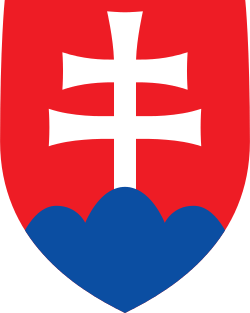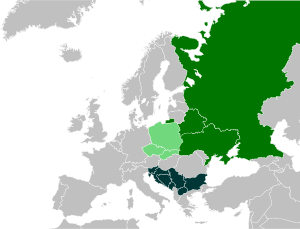Slovaks
|
| |
| Total population | |
|---|---|
| c. 7 million | |
| Regions with significant populations | |
|
| |
| 810,000 i[2] | |
| 200,000 [3] | |
| 100,000 [2] | |
| 90,000 [4] | |
| 52,750 [5] | |
| 29,647 [6] | |
| 28,612 [7] | |
| 25,200 | |
| 22,500 | |
| 17,226 [8] | |
| 16,000 | |
| 15,000 | |
| 12,000 | |
| 10,801 [9] | |
| 6,397 [2] | |
| 4,712 [2] | |
| 4,000 [2] | |
| 3,000 | |
| 2,300 | |
| 2,000 | |
| 1,800 | |
| 1,600 | |
| 1,500 | |
| 800 | |
| Other |
120,000 |
| Languages | |
| Slovak | |
| Religion | |
|
Roman Catholic 73%, Protestant 10.8%, other or unspecified 3.2%, (including 50,363 Orthodox Christians), theism, agnostic or non-religious 13% (2001 census within Slovakia, extrapolated to outside Slovaks) | |
| Related ethnic groups | |
|
Other Slavs, especially other West Slavs Czechs are the most related[10] | |
The Slovaks, Slovak people (Slovak Slováci, singular Slovák, feminine Slovenka, plural Slovenky) are a West Slavic people that primarily inhabit Slovakia and speak the Slovak language.
Most Slovaks today live within the borders of the independent Slovakia (circa 5,410,836). There are Slovak minorities in the Czech Republic, Poland, Hungary, Serbia and sizeable populations of immigrants and their descendants in the United States, Canada and the United Kingdom.
Name
The name Slovak is derived from *Slověninъ, plural *Slověně, the old name of the Slavs. In the Slovak language; only the masculine noun Slověninъ,Slověn changed to Slovän, Slovan and finally (under Czech and Polish influence) to Slovák around 1400. The older form Sloven is preserved in all similar words in the Slovak language - the adjective "Slovak" is still slovenský, the feminine noun "Slovak" is still Slovenka and the country is Slovensko.
The first written mention about usage of the new form Slovak in the territory of present-day Slovakia is from Bardejov (1444) - "Nicoulaus Cossibor hauptman, Nicolaus Czech et Slowak, stipendiarii supremi". The mentions in Czech sources are older - 1375 and 1385.[11] The change is not related to ethnogenesis of Slovaks, but exclusively to linguistic changes in the West Slavic languages. The word Slovak was also used later as a common name for all Slavs in Czech, Polish and also Slovak language in parallel with other forms.[11]
The Slovaks and Slovenes are the only current Slavic nations that have preserved the original name. For Slovenes, the adjective is still slovenski and the feminine noun "Slovene" is still also Slovenka, but the masculine noun has since changed to Slovenec. The Slovak name for their language is slovenčina and the Slovene name for theirs is slovenščina. The Slovak term for the Slovene language is slovinčina; and the Slovenes call Slovak slovaščina. The name is derived from proto-Slavic form slovo "word, talk" (cf. Slovak sluch, which comes from the IE root *ḱlew-). Thus Slovaks as well as Slovenians would mean "people who speak (the same language)", i.e. people who understand each other.
In Hungarian "Slovak" is Tót (pl: tótok), an exonym. It was originally used to refer to all Slavs including Slovenes and Croats, but eventually came to refer primarily to Slovaks. Many place names in Hungary such as Tótszentgyörgy, Tótszentmárton, and Tótkomlós still bear the name. Tóth is a common Hungarian surname.
The Slovaks have also historically been variously referred to as Slovyenyn, Slowyenyny, Sclavus, Sclavi, Slavus, Slavi, Winde, Wende, or Wenden.
Ethnogenesis

The early Slavs came to the territory of Slovakia in several waves from the 5th and 6th centuries and were organized on a tribal level. Original tribal names are not known due to the lack of written sources before their integration into higher political units. Weakening of tribal consciousness was probably accelerated by Avars, who did not respect tribal differences in the controlled territory and motivated remaining Slavs to join together and to collaborate on their defense. In the 7th century, Slavs (including probably also a part of Slovak ancestors) founded larger tribal union - Samo's empire. Regardless of the Samo's empire, the integration process continued also in other territories with various intensity.[12]
The final fall of the Avar Khaganate allowed to arise new political entities. The first such political unit documented by written sources is the Principality of Nitra, one of the foundations of later common ethnic consciousness.[13] In this time, it is not possible yet to assume a common identity of all Slovak ancestors also in the territory of eastern Slovakia, even if it was inhabitated by closely related Slavs. The Principality of Nitra become a part of Great Moravia, a common state of (later) Moravians and Slovaks (Czech ancestors were joined only for a few years). A relatively short existence of the Great Moravia did not allow to suppress differences emerging from its creation from two separate entities or to develop a stronger common "Slovak-Moravian" ethnic identity.[13] The early political integration in the territory of present-day Slovakia was reflected also in language integration. While dialects of early Slovak ancestors were divided into West Slavic (western and eastern Slovakia) and non-West Slavic (central Slovakia), between 8-9th century both dialects merged, thus creating basis of later Slovak language.
The 10th century is a milestone in the Slovak ethnogenesis.[14] The fall of the Great Moravia and further political changes supported their formation into a separate nation. In the same times, old Slavonic language extinct and between 10-13th centuries Slovak evolved into an independent language (simultaneously with other Slavic languages). The early existence of the Kingdom of Hungary positively influenced the development of common consciousness and companionship among Slavs in the Northern Hungary, not only within boundaries of present-day Slovakia.[13] The clear difference between Slovaks and Hungarians made adoption of specific name unnecessary and Slovaks preserved their original name (in Latin e.g. Slavus) used also in contacts with other Slavic peoples (Polonus, Bohemus, Rutenus).[15] In political terms, the medieval Slovaks were a part of the multiethic political nation Natio Hungarica, together with Hungarians, Slavonians, Germans, Romanians and other ethnic groups in the Kingdom of Hungary. Since a medieval political nation did not consist of ordinary people but nobility, for all of them a membership to privilleged class was required (nobiles Hungary).[16]
Like other nations, Slovaks began to transform into a modern nation from the 18th century under the idea of national romanticism. The modern Slovak nation is the result of radical processes of modernization within the Habsburg Empire which culminated in the middle of 19th century.[17] The transformation process was slow down by conflict with Hungarian nationalism and the ethnogenesis of Slovaks become a political question, which should support deprivation or preservation of their national rights. In 1722, Michal Bencsik, professor of law at the University of Trnava, published theory that nobility and burghers of Trenčín should not have same privileges as Hungarians, because they are descendants of Svatopluk's people (inferior to Hungarians). Bencsik nor his Slovak opponent Ján Baltazár Magin did not put the continuity of settlement into serious question. Also the first history of Slovaks written by Georgius Papanek (or Juraj Papánek), traced the roots of the Slovaks to Great Moravia [18] in Historia gentis Slavae. De regno regibusque Slavorum (1780) [History of the Slavic People: On the kingdom and kings of the Slavs]). Papánek's work became a basis for argumentation of the Slovak national revival movement. However, the Slovak national revival not only accepted the continuity of population but also emphasized it, thus proving that Slovaks are equal citizens of the state and Hungarian "unique statesmanlike gift" was nor required for the foundation of the state nor Christianization. In 1876, Hungarian linguist Pál Hunfalvy published a theory about missing continuity between Slovaks and Slavs before the arrival of the Hungarians. Hunfalvy tried to prove that ancestors of Slovaks did not live in the territory of the present-day Slovakia before arrival of the old Hungarians, but Slovaks emerged later from other Slavs who came to the Kingdom of Hungary from neighbouring countries after the 13th century.[19] János Karácsonyi assumed that central and northern Slovakia were uninhabited (1901) and in his next work "Our historical right to the territorial integrity of our country" (1921) he claimed that the rest of original Slavs was assimilated by Hungarians and modern Slovaks are descendants of immigrants from Upper Moravia and Oder (the population density on these territories was too low in that time and higher amount of colonist incoming from these areas was not possible[19]). The theory was then misused by mid-war Hungarian revisionists, who questioned continuity to confirm claims of Hungary on Slovakia. In 1982, when rich archaeological evidences proving opposite were already available,[20] a similar theory has been published again by Hungarian historian György Györffy.[20] Györffy accepted that smaller groups of Slavs could remain in the territory of Slovakia, but the Slovaks origin is in sparse settlement of various Slavic groups later strengthened by later colonization. According to academic Ferenc Makk, the medieval Moravians are not the ancestors of Slovaks and the majority of the Slovak people are descended from latter Slavic newcomers.[21]
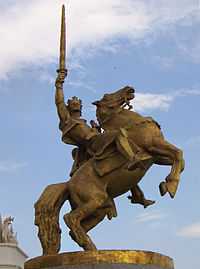
The opposite theory, supporting the supposed former common past of the Czech and Slovak nations, thus also legitimizing the creation of the united Czechoslovak nation,[22] gained political subvention in the mid-war Czechoslovakia.[22] Like Karácsonyi, Czech historian Václav Chaloupecký assumed that northern and central parts of Slovakia remained uninhabited until the 13th century and south-western part was inhabitated by Czechs. Yet in 1946, Chaloupecký assumed that Slovak nation emerged from neighboring Slavs and had been formed only in the 17th century. His theory about the lack of population in the greater part of Slovakia covered by forests were scientifically refuted already by Daniel Rapant (e. g. in his work O starý Liptov, 1934), proved to be wrong by numerous archeologic finds[note 1] and rejected by Czechoslovak histography. On the other hand, mid-war Slovak autonomists, opposing ethnic Czechoslovakism, dated the existence of the Slovak nation to times of Pribina (trials to document existence of Slovaks in early Slavic era i.e. in time of Samo's empire are marginal and exists out of the modern mainstream Slovak histography).
After the dissolution of Czechoslovakia in 1993, the formation of independent Slovakia motivated interest in a particularly Slovak national identity.[23] One reflection of this was the rejection of the common Czechoslovak national identity in favour of a pure Slovak one.[23]
Genetic origins
R1a is the most frequent Haplogroup among Slovaks ranging from 40-45% of the population. The second most frequent Haplogroup in Slovakia is Haplogroup I2 at about 16% followed closely by R1b at about 14%. Autosomally, Slovaks show closest affinity to their Czech neighbors, followed by Polish, Hungarians, and then other eastern European nations. Slovaks also show close genetic affinities with Eastern Austrians.[24]
History
Slavs of the Pannonian Basin
The first known Slavic states on the territory of present-day Slovakia were the Empire of Samo and the Principality of Nitra, founded sometime in the 8th century.
Great Moravia
Great Moravia (833 - ?907) was a Slavic state in the 9th and early 10th centuries, whose creators were the ancestors of the Czechs and Slovaks.[27][28] Important developments took place at this time, including the mission of Greek monks Cyril and Methodius, the development of the Glagolitic alphabet (an early form of the Cyrillic script), and the use of Old Church Slavonic as the official and literary language. Its formation and rich cultural heritage have attracted somewhat more interest since the 19th century.
The original territory inhabited by the Slavic tribes included not only present-day Slovakia, but also parts of present-day Poland, southeastern Moravia and approximately the entire northern half of present-day Hungary.[29]
Kingdom of Hungary


The territory of present day Slovakia became in two parts to part of the Kingdom of Hungary under Hungarian rule gradually from 907 to the early 14th century (major part by 1100) to Upper Hungary and Royal Hungary under the Habsburgs from 1527 - 1848 (see also Hungarian Revolution of 1848) (see also Royal Hungary, Upper Hungary or Kingdom of Hungary) until the formation of Czechoslovakia in 1918.[30] However, according to other historians, from 895 to 902, the whole area of the present-day Slovakia became part of the rising Principality of Hungary, and became (without gradation) part of the Kingdom of Hungary a century later.[31][32][33] A separate entity called Nitra Frontier Duchy, existed at this time within the Kingdom of Hungary. This duchy was abolished in 1107. The territory inhabited by the Slovaks in present-day Hungary was gradually reduced.[34]
When most of Hungary was conquered by the Ottoman Empire in 1541 (see Ottoman Hungary), Upper Hungary (now the territory of present day Slovakia) became the new center of the "reduced" kingdom[35] that remained under Hungarian, and later Habsburg rule, officially called Royal Hungary.[35] Some Croats settled around and in present-day Bratislava for similar reasons. Also, many Germans settled in the Kingdom of Hungary,[35] especially in the towns, as work-seeking colonists and mining experts from the 13th to the 15th century. Jews and Gypsies also formed significant populations within the territory.[35] During the period, most of present Slovakia was part of Habsburg rule, but Ottoman ruled southern and southeasternmos parts of it.
After the Ottoman Empire were forced to retreat from present-day Hungary around 1700, thousands of Slovaks were gradually settled in depopulated parts of the restored Kingdom of Hungary (present-day Hungary, Romania, Serbia, and Croatia) under Maria Theresia, and that is how present-day Slovak enclaves (like Slovaks in Vojvodina, Slovaks in Hungary) in these countries arose.
After Transylvania, Upper Hungary (the territory of present day Slovakia), was the most advanced part of the Kingdom of Hungary for centuries (the most urbanized part, intense mining of gold and silver), but in the 19th century, when Buda/Pest became the new capital of the kingdom, the importance of the territory, as well as other parts within the Kingdom fell, and many Slovaks were impoverished. As a result, hundreds of thousands of Slovaks emigrated to North America, especially in the late 19th and early 20th century (between cca. 1880–1910), a total of at least 1.5 million emigrants.
Slovakia exhibits a very rich folk culture. A part of Slovak customs and social convention are common with those of other nations of the former Habsburg monarchy (the Kingdom of Hungary was in personal union with the Habsburg monarchy from 1867 to 1918).
Czechoslovakia
People of Slovakia spent most part of the 20th century within the framework of Czechoslovakia, a new state formed after World War I. Significant reforms and post-World War II industrialization took place during this time. The Slovak language was strongly influenced by the Czech language during this period.
Contemporary Slovaks
The political transformations of 1989, 1993 restored numerous liberties, which have considerably improved the outlook and prospects of Slovaks.
Contemporary Slovak society organically combines elements of both folk traditions and weestern European lifestyles.
Culture
- See also List of Slovaks
The art of Slovakia can be traced back to the Middle Ages, when some of the greatest masterpieces of the country's history were created. Significant figures from this period included the many Masters, among them the Master Paul of Levoča and Master MS. More contemporary art can be seen in the shadows of Koloman Sokol,[36] Albín Brunovský, Martin Benka,[37] Mikuláš Galanda,[36] Ľudovít Fulla.[36] Julius Koller and Stanislav Filko, in the 21st century Roman Ondak, Blazej Balaz. The most important Slovak composers have been Eugen Suchoň, Ján Cikker, and Alexander Moyzes, in the 21st century Vladimir Godar and Peter Machajdík.
The most famous Slovak names can indubitably be attributed to invention and technology. Such people include Jozef Murgaš, the inventor of wireless telegraphy; Ján Bahýľ, Štefan Banič, inventor of the modern parachute; Aurel Stodola, inventor of the bionic arm and pioneer in thermodynamics; and, more recently, John Dopyera, father of modern acoustic string instruments. Hungarian inventors Joseph Petzval and Stefan Jedlik were born of Slovak fathers.
Slovakia is also known for its polyhistors, of whom include Pavol Jozef Šafárik, Matej Bel, Ján Kollár, and its political revolutionaries, such Milan Rastislav Štefánik and Alexander Dubček.
There were two leading persons who codified the Slovak language. The first one was Anton Bernolák whose concept was based on the dialect of western Slovakia (1787). It was the enactment of the first national literary language of Slovaks ever. The second notable man was Ľudovít Štúr. His formation of the Slovak language had principles in the dialect of central Slovakia (1843).
The best known Slovak hero was Juraj Jánošík (the Slovak equivalent of Robin Hood). The prominent explorer and diplomat Móric Beňovský, Hungarian transcript Benyovszky was Slovak as well (he comes from Vrbové in present day Slovakia and is e.g. listed as "nobilis Slavicus - Slovak nobleman" in his secondary school registration).
In terms of sports, the Slovaks are probably best known (in North America) for their ice hockey personalities, especially Stan Mikita, Peter Šťastný, Peter Bondra, Žigmund Pálffy, Marián Hossa and Zdeno Chára. For a list see List of Slovaks. Zdeno Chára is only the second European captain in history of the NHL that led his team to win the Stanley Cup, winning it with Boston Bruins in season 2010–11.
For a list of the most notable Slovak writers and poets, see List of Slovak authors.
-
Girl from Slovakia
-
 Moravian-Slovak folk festival
Moravian-Slovak folk festival -
 Easter in Slovakia
Easter in Slovakia -
 Slovak peasant from the Tatra Mountains, 1908
Slovak peasant from the Tatra Mountains, 1908 -
 Jan Francisci-Rimavsky poet and revolutionary
Jan Francisci-Rimavsky poet and revolutionary -
 Viola Valachová
Viola Valachová
partisan -
 Adriana Sklenaříková, fashion model and actress
Adriana Sklenaříková, fashion model and actress -
 Jana Kirschner, pop singer
Jana Kirschner, pop singer -
.jpg) Daniela Hantuchová, the most successful Slovak tennis player of all time
Daniela Hantuchová, the most successful Slovak tennis player of all time -
 Stan Mikita, ice hockey player and member of the Hockey Hall of Fame
Stan Mikita, ice hockey player and member of the Hockey Hall of Fame -
 Peter Šťastný, ice hockey player and member of the Hockey Hall of Fame
Peter Šťastný, ice hockey player and member of the Hockey Hall of Fame -
 Zdeno Chára, ice hockey player and captain of Boston Bruins
Zdeno Chára, ice hockey player and captain of Boston Bruins -
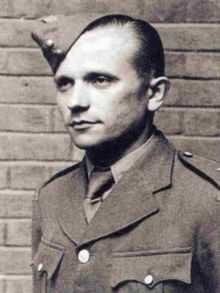 Jozef Gabčík, Slovak soldier, assassin of Reinhard Heydrich
Jozef Gabčík, Slovak soldier, assassin of Reinhard Heydrich -

-
 Miroslav Iringh, one of the Warsaw Uprising organisers
Miroslav Iringh, one of the Warsaw Uprising organisers -
.jpg) Winter Ave Zoli, actress known for her role as Lyla Winston in Sons of Anarchy. Her father was Slovak, and she was raised in Prague
Winter Ave Zoli, actress known for her role as Lyla Winston in Sons of Anarchy. Her father was Slovak, and she was raised in Prague
Statistics
There are approximately 5.4 million autochthonous Slovaks in Slovakia. Further Slovaks live in the following countries (the list shows estimates of embassies etc. and of associations of Slovaks abroad in the first place, and official data of the countries as of 2000/2001 in the second place).
The list stems from Claude Baláž, a Canadian Slovak, the current plenipotentiary of the Government of the Slovak Republic for Slovaks abroad (see e.g.: 6):
- USA (1,200,000 / 821,325*) [*(1)there were, however, 1,882,915 Slovaks in the US according to the 1990 census, (2) there are some 400,000 "Czechoslovaks" in the US, a large part of which are Slovaks] - 19th - 21st century emigrants; see also United States Census[38]
- Czech Republic (350,000 / 183,749*) [*there were, however, 314 877 Slovaks in the Czech Republic according to the 1991 census] - due to the existence of former Czechoslovakia
- Hungary (39,266 / 17,693)
- Canada (100,000 / 50,860) - 19th - 21st century migrants
- Serbia (60,000 / 59,021*) [especially in Vojvodina;*excl. the Rusins] - 18th & 19th century settlers
- Poland (2002) (47,000 / 2,000*) [* The Central Census Commission has accepted the objection of the Association of Slovaks in Poland with respect to this number ]- ancient minority and due to border shifts during the 20th century
- Romania (18,000 / 17,199) - ancient minority
- Ukraine (17,000 / 6,397) [especially in Carpathian Ruthenia] - ancient minority and due to the existence of former Czechoslovakia
- France (13,000/ n.a.)
- Australia (12,000 / n.a.) - 20th - 21st century migrants
- Austria (10,234 / 10,234) - 20th - 21st century migrants
- United Kingdom (10,000 / n.a.)
- Croatia (5,000 / 4,712) - 18th & 19th century settlers
- other countries
The number of Slovaks living outside Slovakia in line with the above data was estimated at max. 2,016,000 in 2001 (2,660,000 in 1991), implying that, in sum, there were max. some 6 630 854 Slovaks in 2001 (7,180,000 in 1991) in the world. The estimate according to the right-hand site chart yields an approximate population of Slovaks living outside Slovakia of 1.5 million.
Other (much higher) estimates stemming from the Dom zahraničných Slovákov (House of Foreign Slovaks) can be found on SME.[39]
See also
- History of the Slovak language
- Slovak Americans
- Slovaks in Bulgaria
- Slovaks in Canada
- Slovaks of Croatia
- Slovaks in the Czech Republic
- Slovaks in Hungary
- Slovaks of Romania
- Slovaks in Serbia
- Slovaks in Vojvodina
- Slovenes
- List of Slovak Americans
- List of Slovaks
Notes
- ↑ For example Slavic mounds in Krasňany near Žilina, cemetery in Martin, magnate mounds in Turčianska Blatnica, Malý Čepčín and Žabokreky, settlements in Liptovský Michal, Liptovská Mara (unearthed during construction of the water dam), Vlachy, Liptovská Štiavnica, Paludza, Sokolče, Lisková, Podtureň, Prosiek, Bobrovník, Likavka - all of them from 8-10th century. (Uhlár, 1992, p. 326)
References
- ↑ The Slovak Spectator: Census: Fewer Hungarians, Catholics – and Slovaks, 5 Mar 2012
- ↑ 2.0 2.1 2.2 2.3 2.4 (2010 census)
- ↑ "CIA.gov". Retrieved 14 November 2014.
- ↑ "Population by Country of Birth & Nationality, Apr 2009 to Mar 2010 (UK)". Retrieved 14 November 2014.
- ↑ http://webrzs.stat.gov.rs/WebSite/userFiles/file/Aktuelnosti/Prezentacija_Knjiga1.pdf
- ↑ "Hungarian census 2011" (PDF). ksh.hu.
- ↑ Statistik Austria. "STATISTIK AUSTRIA - Bevölkerung nach Staatsangehörigkeit und Geburtsland". Retrieved 14 November 2014.
- ↑ "Transindex.ro". Retrieved 14 November 2014.
- ↑ "CSO Emigration" (PDF). Census Office Ireland. Retrieved January 29, 2013.
- ↑ "Ethnologue - Slavic languages". www.ethnologue.com. Retrieved 2011-03-16.
- ↑ 11.0 11.1 Marek 2011, p. 67.
- ↑ Marsina 2013, p. 65.
- ↑ 13.0 13.1 13.2 Marsina 2013, p. 67.
- ↑ Marsina & 2009 16.
- ↑ Marsina 2013, p. 71.
- ↑ Marek 2011, p. 13.
- ↑ Stefan Auer, Liberal Nationalism in Central Europe, Routledge, 2004, p. 135
- ↑ Kamusella 2009, p. 134
- ↑ 19.0 19.1 Marsina 2009, p. 18.
- ↑ 20.0 20.1 Marsina 2009, p. 19.
- ↑ Ferenc, Makk, "És erővel elfoglalta egész Pannóniát", In: Tiszatáj, 1996-10, p. 76
- ↑ 22.0 22.1 Marsina 1997, p. 17
- ↑ 23.0 23.1 W. Warhola, James (2005). "Changing Rule Between the Danube and the Tatras: A study of Political Culture in Independent Slovakia, 1993 - 2005" (PDF). The University of Maine. Orono, Maine, United States.: Midwest Political Science Association 2005 Annual National Conference, April 9, 2005. Retrieved 2011-06-15.
- ↑ "European Y-DNA haplogroups frequencies by country". Eupedia.
- ↑ Kirschbaum 1995, p. 25
- ↑ Bagnell Bury, John (1923). The Cambridge Medieval History. Cambridge: Macmillan. p. 211.
- ↑ Ference Gregory Curtis. Chronology of 20th-century eastern European history. Gale Research, Inc., 1994. ISBN 978-0-8103-8879-6, p. 103
- ↑ Věd), Archeologický Ústav (Československá Akademie (1964). "The Great Moravia Exhibition: 1100 years of tradition of state and cultural life".
- ↑ A history of Eastern Europe: crisis and change, Robert Bideleux, Ian Jeffries
- ↑ Eberhardt 2003, p. 105
- ↑ Kristó, Gyula (1996). Hungarian History in the Ninth Century. Szeged: Szegedi Középkorász Műhely. p. 229. ISBN 963-482-113-8
- ↑ "Histria 2001/03. - GYRFFY GYRGY: Honfoglals a Krpt-medencben". Retrieved 14 November 2014.
- ↑ Kristó, Gyula (1993). A Kárpát-medence és a magyarság régmúltja (1301-ig) (The ancient history of the Carpathian Basin and the Hungarians - till 1301) Szeged: Szegedi Középkorász Műhely. p. 299. ISBN 963-04-2914-4.
- ↑ Vauchez, André; Barrie Dobson, Richard; Lapidge, Michael (2000). Encyclopedia of the Middle Ages 1. Routledge. p. 1363. ISBN 9781579582821.
- ↑ 35.0 35.1 35.2 35.3 Eberhardt 2003, p. 104
- ↑ 36.0 36.1 36.2 Marshall Cavendish Corporation (2009). "Slovakia; Cultural expression". World and Its Peoples 7. Marshall Cavendish. p. 993. ISBN 9780761478836.
- ↑ Mikuš 1977, p. 108
- ↑ http://www.census.gov/prod/2004pubs/c2kbr-35.pdf
- ↑ (Slovak) SME.sk
- Slovaks in Czech Republic
- Slovaks in Hungary
- Baláž, Claude: Slovenská republika a zahraniční Slováci. 2004, Martin
- Baláž, Claude: (a series of articles in:) Dilemma. 01/1999 – 05/2003
Sources
- Marsina, Richard (1995). Nové pohľady historickej vedy na slovenské dejiny. I. časť. Najstaršie obdobie slovenských dejín (do prelomu 9.-10. storočia) (in Slovak). Bratislava: Metodické centrum mesta Bratislavy. ISBN 80-7164-069-7.
- Marsina, Richard (1997). Ethnogenesis of Slovaks, Human Affairs, 7, 1997, 1. Trnava, Slovakia: Faculty of Humanities, University of Trnava.
- Marsina, Richard (2009). "K problematike etnogenézy Slovákov a ich pomenovania". In Marsina, Richard; Mulík, Peter. Etnogenéza Slovákov (in Slovak). Martin: Matica slovenská. ISBN 978-80-7090-940-9.
- Marek, Miloš (2009). Národnosti Uhorska [Nationalities in the Kingdom of Hungary] (in Slovak). Trnava: University of Trnava. ISBN 978-80-8082-470-9.
- Uhlár, Vlado (1992). "Osídlenie Liptova a dolnoliptovské nárečia" (PDF). Slovenská reč (in Slovak) (Bratislava: Slovak Academic Press).
- Kamusella, Tomasz (2009). The Politics of Language and Nationalism in Modern Central Europe. Basingstoke, UK (Foreword by Professor Peter Burke): Palgrave Macmillan. ISBN 9780230550704.
- Kirschbaum, Stanislav J. (March 1995). A History of Slovakia: The Struggle for Survival. New York: Palgrave Macmillan; St. Martin's Press. p. 25. ISBN 978-0-312-10403-0.
- Malyarchuk, B.A.; Perkova, M.A.; Derenko, M.V.; Vanecek, T.; Lazur, J.; Gomolcak, P. (2008). "Mitochondrial DNA Variability in Slovaks, with Application to the Roma Origin". Annals of Human Genetics (Journal compilation 2008 University College London) 72 (2): 228. doi:10.1111/j.1469-1809.2007.00410.x.
- Eberhardt, Piotr (2003). Ethnic Groups and Population Changes in Twentieth-Century Central-Eastern Europe: History, Data, Analysis. M.E. Sharpe. ISBN 978-0-7656-0665-5.
- Mikuš, Joseph A. (1977). Slovakia and the Slovaks. Three Continents Press. ISBN 9780914478881.
The work is superbly illustrated by Martin Benka, a Slovak painter of comparable
Maps
-
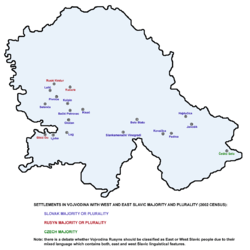
Slovaks in Vojvodina, Serbia (2002 census)
-

The language spread of Slovak in the United States according to U. S. Census 2000 and other resources interpreted by research of U. S. English Foundation, percentage of home speakers
External links
| Wikimedia Commons has media related to Slovaks. |
| Wikisource has the text of the 1920 Encyclopedia Americana article Slovaks. |
- Some studies on the early Slovaks and Slavs, on the Slovak language and Slovak hydronymy
- Slovaks in America (Library of Congress)
- The Slovaks in the Kingdom of Hungary according to the (disputed) 1910 census
| |||||||||||||||||||||||||||||||||||||||||||||||||||
| ||||||||||||||||

.jpg)

